|
This Site:
Civil War
Civil War Overview
Civil War 1861
Civil War 1862
Civil War 1863
Civil War 1864
Civil War 1865
Civil War Battles
Confederate Generals
Union Generals
Confederate History
Robert E. Lee
Civil War Medicine
Lincoln Assassination
Slavery
Site Search
Civil War Links
Civil War Art
Revolutionary War
Mexican War
Republic of Texas
Indians
Winslow Homer
Thomas Nast
Mathew Brady
Western Art
Civil War Gifts
Robert E. Lee Portrait
|
|
Petersburg.
This city, on the south side of the Appomattox River, about 20 miles
from Richmond, and 15 from City Point, was occupied, in the summer of 1864,
by a large Confederate force, who cast up strong entrenchments upon its
exposed sides. When the Army of the Potomac was led to the south side of the
James River (June 14–16, 1864), it began immediate operations against
Petersburg, which was then the strong defense of Richmond. Butler, at
Bermuda Hundred, was very securely entrenched.
Grant sent General Smith's
troops quickly back to him after the battle
at COLD HARBOR, |
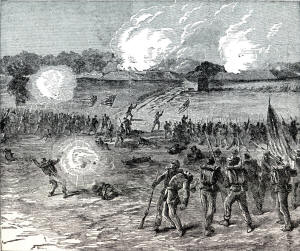
ATTACKING THE CONFEDERATE ENTRENCHMENTS AT THE BATTLE OF PETERSBURG
|
|
and directed him to cooperate with the Army of the
Potomac in an attempt to capture Petersburg. On June 10 Butler sent 10,500
men, under Gilimore, and 1,500 cavalry, under Kautz, to attack the
Confederates at Petersburg; at the same time two gunboats went up the
Appomattox to bombard an earthwork a little below the city. The troops
crossed the Appomattox 4 miles above City Point, and marched on Petersburg,
while Kautz swept round to attack on the south. The enterprise was a
failure, and the Nationals retired. Five days later there was another
attempt to capture Petersburg. Smith arrived at Bermuda Hundred with his
troops on June 14, and pushed on to the front of the defenses of Petersburg,
northeastward of the city. These were found to be very formidable and,
ignorant of what forces lay behind these works, he proceeded so cautiously
that it was near sunset (June 15), before he was prepared for an assault.
The Confederates were driven from their strong line of rifle-pits.
Pushing on, Smith captured a powerful salient, four
redoubts, and a connecting line of entrenchments about 2 1/2 miles in
extent, with 15 guns and 300 prisoners. Two divisions of
Hancock's corps had
come up, and rested upon their arms within the works just captured. While
these troops were reposing, nearly the whole of
Robert E. Lee's army were crossing
the James River at Richmond, and troops were streaming down towards
Petersburg to assist in its defense, and during the night (June 15–16) very
strong works were thrown up. The coveted prize was lost. Twenty-four hours
before, Petersburg might have been easily taken; now it defied the
Nationals, and endured a most distressing siege for ten months longer. At
the middle of June, a large portion of the Army of Northern Virginia was
holding the city and the surrounding entrenchments, and a great part of the
Army of the Potomac, with the command of Smith upon its right, confronted
the Confederates. On the evening of the 16th a heavy bombardment was opened
upon the Confederate works, and was kept up until 6 A.M. the next day Birney,
of Hancock's corps, stormed and carried a redoubt on his front, but
Burnside's corps could make no impression for a long time, in the face of a
murderous fire. There was a general advance of the Nationals, but at a
fearful cost of life. At dawn General Potter's division of
Burnside's corps
charged upon the works in their front, carried them, and captured four guns
and 400 men. He was relieved by General Ledlie's column, which advanced to
within half a mile of the city, and held a position from which shells might
be cast into the town. They were driven back with great loss.
On the same day (June 16) General Butler sent out
General
Terry to force General Beauregard's
lines, and destroy and hold, if possible, the railway in that vicinity. He
had gained possession of the track, and was proceeding to destroy it, when
he was attacked by a division of General
James Longstreet's corps, on its way from Richmond to Petersburg. Terry
was driven back to the entrenchments at Bermuda Hundred before aid could
reach him. On the morning of the 17th the 7th and 9th Corps renewed the
attack upon the works at Petersburg, when the hill upon which Fort Steadman
was afterwards built was carried and held by the former. Another attack was
made by the 9th Corps in the afternoon, and a severe battle began, and
continued until night, with great slaughter. Desperate attempts had been
made to recapture what the Confederates had lost, and that night a heavy
Confederate force drove back the 9th (Burnside's) Corps. A general assault
was made on the 18th, with disaster to the Nationals, who were repulsed at
every point.
Then, after a loss of nearly 10,000 men, further attempts
to take Petersburg by storm were abandoned for a while, and Grant prepared
for a regular siege. |
|
He at once began entrenching, and to extend his left in
the direction of the Petersburg and Weldon Railway, which he desired to
seize, and thus envelop Petersburg with his army. He moved the corps of
Hancock and Wright stealthily to the left, to attempt to turn the
Confederate right. The former was pushed back. |
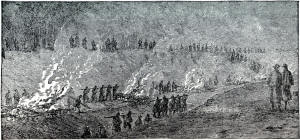
TEARING UP THE RAILROAD AT THE BATTLE OF PETERSBURG.
|
|
On the following morning (June 22, 1864) the Nationals were attacked by
divisions of the corps of A. P.
Hill, driving back a portion of them with heavy loss. At sunset Meade
came up and ordered both corps to advance and retake what had been lost. It
was done, when Hill retired
with 2,500 prisoners. The next morning Hancock and Wright advanced, and
reached the Weldon road without much opposition, until they began to destroy
it, when a part of Hill's
corps drove off the destroyers. The National line had now been extended to
the Weldon road. Meanwhile a cavalry expedition. 8,000 strong, under Kautz
and Wilson, had been raiding upon the railways leading southward from
Petersburg, the latter being in chief command. They destroyed the buildings
at Reams's Station, 10 miles south of Petersburg, and the track for a long
distance. They then struck the Southside Railway, and destroyed it over a
space of 20 miles, fighting and defeating a cavalry force under Fitzhugh
Lee. Kautz pushed on, and tore up the track of the Southside and Danville
railways, at and near their junction. The united forces destroyed the
Danville road to the Staunton River, where they were confronted by a large
force of Confederates. They were compelled to fight their way back to
Reams's Station, on the Weldon road, which they had left in the possession
of the Nationals; but they found the cavalry of
Wade Hampton there, and a considerable body of Confederate infantry. |
|
In attempting to force their way through them, the Nationals were defeated,
with heavy loss, and they made their way back to camp with their army of
troopers. Their estimated loss during the raid was nearly 1,000 men.
Now, after a struggle for two months, both armies were willing to seek
repose, and for some time there was a lull in the storm of strife. |
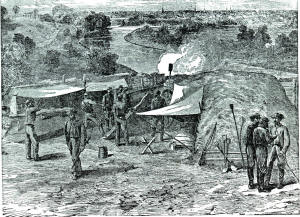
SCENE AT THE SIEGE OF PETERSBURG. |
|
The Union army lay in front of a formidable line of
redans and redoubts, with lines of entrenchments and abatis, altogether 40
miles in length, extending from the left bank of the Appomattox around to
the western side of Petersburg, and to and across the James to the
northeastern side of Richmond. Within eight or nine weeks, the Union army,
investing Petersburg, had lost, in killed, wounded, and prisoners, about
70,000 men. Reinforcements had kept up its numbers, but not the quality of
its materials. Many veterans remained, but a vast number were raw troops.
The Nationals continued building fortifications and preparing for an
effective siege. Butler, by a quick movement, had thrown Foster's brigade
across the James River at Deep Bottom, and formed an entrenched camp there,
within 10 miles of Richmond, and connected with the army at Bermuda Hundred
by a pontoon bridge. By this movement a way was provided to move heavy
masses of troops to the north side of the James at a moment's warning, if
desired. Robert E. Lee met this by
laying a similar bridge at Drury's Bluff. By the close of July, 1864, Grant
was in a position to choose his method of warfare—whether by a direct
assault, by the slower process of a regular siege, or by heavy operations on
the flanks of the Confederates.
The regular siege of Petersburg began in July. On June 25
operations were started for mining under the Confederate forts so as to blow
them up. One of these was in charge of Lieutenant-Colonel Pleasants, who
completed it on July 22. When the mine was ready Grant sent Hancock to
assist Foster to flank the Confederates at Deep Bottom, and, pushing on to
Chapin's Bluff, below Drury's Bluff, to menace
Lee's line of communications across
the river. It was done; and, to meet the seeming impending danger to
Richmond, Robert E. Lee withdrew
five of his eight remaining divisions on the south side of the James,
between the 27th and the 29th. Grant's opportunity for a grand assault now
offered. The mine under one of the principal forts was exploded early on the
morning of July 30, with terrible effect. In the place of the fort was left
a crater of loose earth, 200 feet in length, fully 50 feet in width, and
from 20 to 30 feet in depth. The fort, its guns, and other munitions of war,
with 300 men, were thrown high in air and annihilated. Then the great guns
of the Nationals opened a heavy cannonade upon the remainder of the
Confederate works, with precision and fatal effect, all along the line, but
owing partly to the slowness of motion of a portion of the assaulting force,
the result was a most disastrous failure on the part of the assailants.
A fortnight later
General Grant sent another expedition
to the north side of the James, at Deep Bottom, composed of the divisions of Birney and Hancock, with cavalry under Gregg. They had sharp engagements
with the Confederates on Aug. 13, 16, and 18, in which the Nationals lost
about 5,000 men without gaining any special advantage excepting the
incidental one of giving assistance to troops sent to seize the Weldon
Railway south of Petersburg. This
General Warren effected on Aug. 18. Three
days afterwards he repulsed a Confederate force which attempted to recapture
the portion of the road held by the Unionists; and on the same day (Aug. 21)
General Hancock, who had returned from the north side of the James, struck
the Weldon road at Reams's Station and destroyed the track for some
distance. The Nationals were finally driven from the road with considerable
loss.
For a little more than a month after this there was
comparative quiet in the vicinity of Petersburg and Richmond. The National
troops were moved simultaneously towards each city. General Butler, with the
corps of Birney and Ord, moved upon and captured Fort Harrison on Sept. 29.
These troops charged upon another fort near by, but were repulsed with heavy
loss. Among the slain was General Burnham, and Ord was severely wounded. In
honor of the slain general the captured works were named Fort Burnham. In
these assaults the gallantry of the colored troops was conspicuous.
Meanwhile, Meade had sent
Generals Warren and Parke, with two divisions of
troops each, to attempt the extension of the National left to the Weldon
road and beyond. It was a feint in favor of Butler's movement on the north
side of the James, but it resulted in severe fighting on Oct. 1 and 2, with
varying fortunes for both parties. Then there was another pause, but not a settied rest, for about two months, when the greater portion of the Army of
the Potomac was massed on the Confederate right, south of the James. |
|
On Oct. 27 they assailed
Robert E. Lee's works on Hatcher's
Run, westward of the Weldon road, where a severe struggle ensued. The
Nationals were repulsed, and, on the 29th, they withdrew to their
entrenchments in front of Petersburg. Very little was done by the Army of
the Potomac until the opening of the
spring campaign of 1865. The losses of
that army had been fearful during six months, from the beginning of May
until November, 1864. The aggregate number in killed, wounded, missing, and
prisoners was over 80,000 men, of whom nearly 10,000 were killed in battle. |
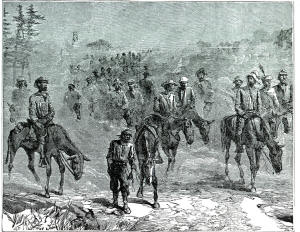
THE RETURN OF THE CAVALRY. |
|
Add to these the losses of the Army of the James during
the same period, and the sum would be fully 100,000 men. The Army of the
Potomac had captured 15,378 prisoners, sixty-seven colors, and thirty-two
guns. They had lost twenty-five guns. The Confederates had lost, including
15,000 prisoners, about 40,000 men.
The Army of the Potomac had its winter quarters in front
of the Army of Northern Virginia in 1864-65. The left of the former held a
tight grasp upon the Weldon road, while the Army of the James, on the north
side of that river, and forming the right of the besiegers of Petersburg and
Richmond, had its pickets within a few miles of the latter city. Sheridan,
at the same time, was at Kernstown, near
Winchester, full master of the
Shenandoah Valley from Harper's Ferry to Staunton. Grant's chief business
during the winter was to hold Robert E.
Lee tightly while
Sherman, Thomas, and
Canby were making their important
conquests, in accordance with the comprehensive plan of the
lieutenant-general. The leaders in the Confederate government at Richmond
contemplated the abandonment of Virginia and the concentration of the troops
of Lee and Johnston south of the
Roanoke. The politicians of Virginia would not allow such a movement, nor
would Lee have led the Army of
Northern Virginia out of that State; so, President Davis and his advisers
had to abandon their project. Besides, Grant held Lee so firmly that he had
no free choice- in the matter.
It was near the close of March, 1865, before Grant was
ready for a general movement against Lee.
Early in December Warren had seized the Weldon road farther south than had
yet been done. He destroyed it (Dec. 7) all the way to the Meherin River,
meeting with little opposition. A few weeks later there was some sharp
skirmishing between Confederate gunboats and National batteries near
Dutch
Gap Canal. A little later a movement was made on the extreme left of the
Nationals to seize the Southside Railway and to develop the strength of
Lee's right. The entire army in
front of Petersburg received marching orders, and, on Feb. 6, the flanking
movement began. After a sharp fight near Hatcher's Run, the Nationals
permanently extended their left to that stream. Grant now determined to cut
off all communication with Richmond north of that city. The opportunity
offered towards the middle of February.
Lee had drawn the greater portion of his forces from the Shenandoah
Valley, and Sheridan, under instructions, made a grand cavalry raid against
the northern communications with the Confederate capital, and especially for
the seizure of Lynchburg. It was a most destructive march, and very
bewildering to the Confederates.
This raid, the junction of the National armies in North
Carolina, and the operations at
Mobile and in Central Alabama satisfied
Lee that he could no longer maintain
his position, unless, by some means, his army might be vastly increased and
new and ample resources for its supply obtained. He had recommended the
emancipation of the slaves and making
soldiers of them, but the slave interest was too powerful in the civil
councils of the Confederacy to obtain a law to that effect. Viewing the
situation calmly, he saw no hope for the preservation of his army from
starvation or capture, nor for the existence of the
Confederacy, except in
breaking through Grant's lines and forming a junction with
Johnston in North Carolina. He knew such
a movement would be perilous, but he resolved to attempt it; and he prepared
for a retreat from the Appomattox to the Roanoke. Grant saw symptoms of such
a movement, and, on March 24, 1865, issued an order for a general forward
movement on the 29th. On the 25th Lee's
army attempted to break the National line at the strong point of Fort
Steadman, in front of the 9th Corps. They also assailed Fort Haskell, on the
left of Fort Steadman, but were repulsed. These were sharp but fruitless
struggles by the Confederates to break the line. The grand movement of the
whole National army on the 29th was begun by the left, for the purpose of
turning Lee's right, with an
overwhelming force. At the same time Sheridan was approaching the Southside
Railway to destroy it. Lee's right
entrenched lines extended beyond Hatcher's Run, and against these and the
men who held them the turning column marched. General Ord, with three
divisions of the Army of the James, had been drawn from the north side of
that river and transferred to the left of the National lines
before
Petersburg. The remainder of Ord's command was left in charge of General
Weitzel, to hold the extended lines of the Nationals, fully 35 miles in
length.
Sheridan reached Dinwiddie Courthouse towards the evening
of March 29. Early that morning the corps of Warren (5th) and Humphreys
(2nd) moved on parallel roads against the flank of the Confederates, and,
when within 2 miles of their works, encountered a line of battle. A sharp
fight occurred, and the Confederates were repulsed, with a loss of many
killed and wounded and 100 made prisoners. Warren lost 370 men.
Lee now fully comprehended the
perils that menaced him. The only line of communication with the rest of the
Confederacy might be cut at any hour. He also perceived the necessity of
strengthening his right to avert the impending shock of battle; likewise of
maintaining his extended line of works covering Petersburg and Richmond. Not
aware of the withdrawal of troops from the north side of the James, he left
James Longstreet's corps, 8,000 strong,
to defend Richmond. Robert E. Lee
had massed a great body of his troops—some 15,000-at a point in front of the
corps of Warren and Humphreys, the former on the extreme right of the
Confederates. There Lee attempted
(March 30) to break through the National lines, and for a moment his success
seemed assured. A part of the line was pushed back, but Griffin's division
stood firm and stemmed the fierce torrent, while Ayres and Crawford reformed
the broken column. |
|
Warren soon assumed the offensive, made a countercharge,
and, by the aid of a part of Hancock's corps, drove back the Confederates.
Lee then struck another blow at a
supposed weak point on the extreme left of the Nationals, held by Sheridan.
A severe battle ensued. Both parties lost heavily.On the evening of the same
day all the National guns in front of Petersburg opened on the Confederate
lines from Appomattox to Hatcher's Run. |
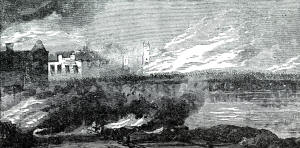
EVACUATION OF PETERSBURG. |
|
Wright, Parke, and Ord, holding the entrenchments at
Petersburg, were ordered to follow up the bombardment with an assault. The
bombardment was kept up until 4 A.M. (April 2), and the assault began at
daybreak. Parke carried the outer line of the Confederate works in his
front, but was checked at an inner line. Wright drove everything before him
to the Boydton plank road, where he turned to the left towards Hatcher's
Run, and, pressing along the rear of the Confederate entrenchments, captured
several thousand men and many guns. Ord's division broke the Confederate
division on Hatcher's Run, when the combined forces swung round to the right
and pushed towards Petersburg from the southwest. On the same day the
Southside Railway was first struck at three points by the Nationals, who had
driven the Confederates from their entrenchments and captured many. This
achievement effectually cut off one of
Lee's most important communications. Gibbon's division of Ord's command
captured two strong redoubts south of Petersburg. In this assault Gibbon
lost about 500 men. The Confederates were now confined to an inner line of
works close around Petersburg. James
Longstreet went to the help of Lee,
and the latter ordered a charge to be made to recover some of the lost
entrenchments. It failed; and so ended the really last blow struck for the
defense of Richmond by Lee's army.
General A. P. Hill, one of
Lee's best officers, was shot dead
while reconnoitering. Lee now
perceived that he could no longer hold Petersburg or the capital with safety
to his army. At 10.30 on Sunday morning (April 2) he telegraphed to the
government at Richmond: "My lines are broken in three places; Richmond must
be evacuated this evening." Then Lee's
troops withdrew from Petersburg, and the struggle there ended.
|
|




